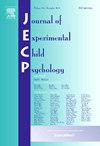眼不见,心不烦:10 个月和 12 个月大德国婴儿瞳孔测量法关于物体永恒性的新证据
IF 1.8
2区 心理学
Q3 PSYCHOLOGY, DEVELOPMENTAL
引用次数: 0
摘要
关于出生后第一年内早期物体表征的出现和解释,采用观察时间测量法和基于动作测量法的研究结果存在很大差异。瞳孔测量法是一种很有前途的新方法,它能证明 18 个月大的婴儿具有物体永恒性,但目前还没有更小的婴儿具有物体永恒性。在本研究中,我们通过一种专为低龄婴儿设计的瞳孔测量违反期望范式,重新研究了闭塞事件后的物体永存性。在每次试验中,婴儿都会观察到一个玩具物体的闭塞,并在预期条件下及时显示出来,或在意外条件下不显示出来。在两次实验中,我们发现 10 个月和 12 个月大的婴儿(总人数 = 82)在意外物体消失时,瞳孔会相对于预期物体出现时放大。对照分析表明,在排除感知解释的情况下,实验操作前的场景之间没有差异。我们还进一步报告了条件对瞳孔反应的年龄依赖性影响,在年龄较大的组别中,意外结果引发的瞳孔放大更大。这些结果提供了积极的瞳孔测量证据,支持在 10 个月和 12 个月大时,在违反期望范式下的物体永恒性。本文章由计算机程序翻译,如有差异,请以英文原文为准。
Out of sight, not out of mind: New pupillometric evidence on object permanence in a sample of 10- and 12-month-old German infants
Findings on the emergence and interpretation of early object representation in the first year of life diverge widely between designs that employ looking times versus action-based measures. As a promising new approach, pupillometry has produced evidence for object permanence at 18 months of age, but not younger as of yet. In the current study, we (re)investigated object permanence following occlusion events in a pupillometric violation-of-expectation paradigm optimized for younger infants. During each trial, infants observed a toy object’s occlusion and prompt reveal in the expected condition or its absence in the unexpected condition. Across two experiments, we show that 10- and 12-month-old infants’ (total N = 82) pupils dilate in response to unexpected object disappearances relative to expected appearances. Control analyses revealed no differences between the scenes before the experimental manipulation, excluding perceptual interpretations. We further report an age-dependent effect of condition on pupil responses, with unexpected outcomes triggering greater pupil dilation in the older group. These results provide positive pupillometric evidence in support of object permanence in the context of a violation-of-expectation paradigm at 10 and 12 months of age.
求助全文
通过发布文献求助,成功后即可免费获取论文全文。
去求助
来源期刊

Journal of Experimental Child Psychology
Multiple-
CiteScore
4.50
自引率
7.70%
发文量
190
期刊介绍:
The Journal of Experimental Child Psychology is an excellent source of information concerning all aspects of the development of children. It includes empirical psychological research on cognitive, social/emotional, and physical development. In addition, the journal periodically publishes Special Topic issues.
 求助内容:
求助内容: 应助结果提醒方式:
应助结果提醒方式:


